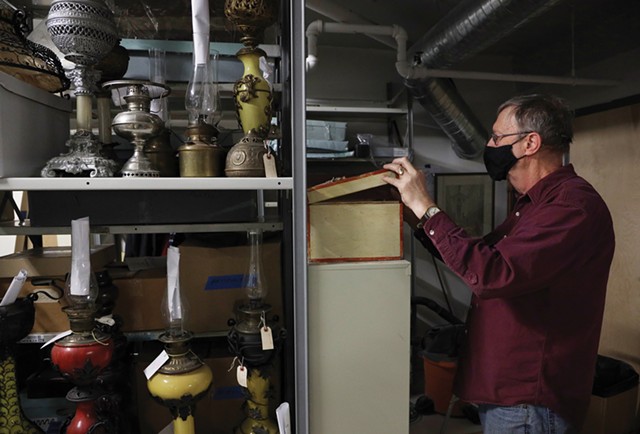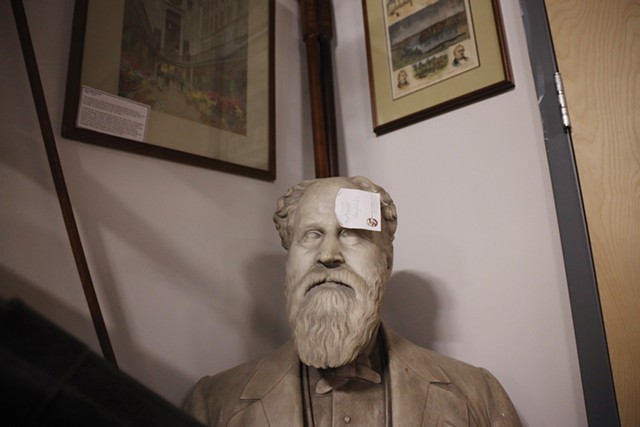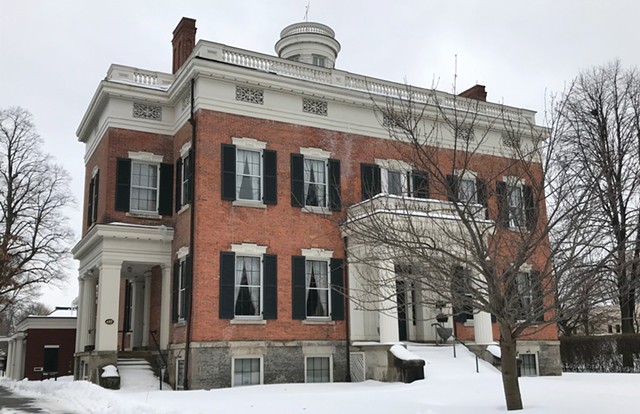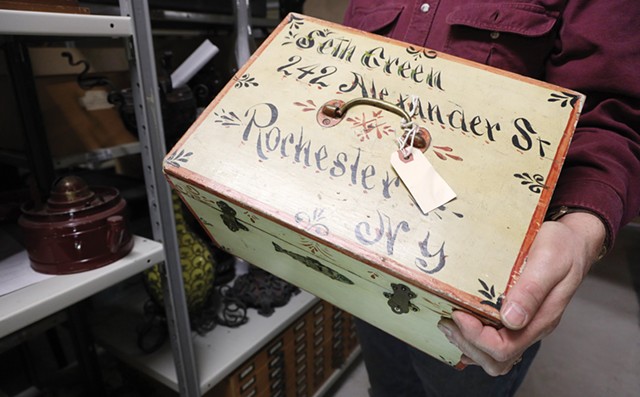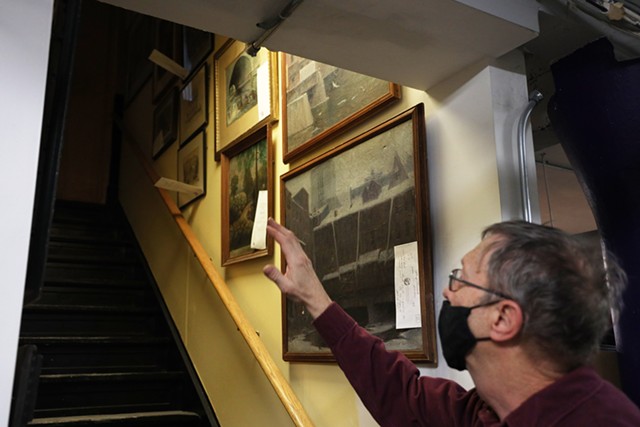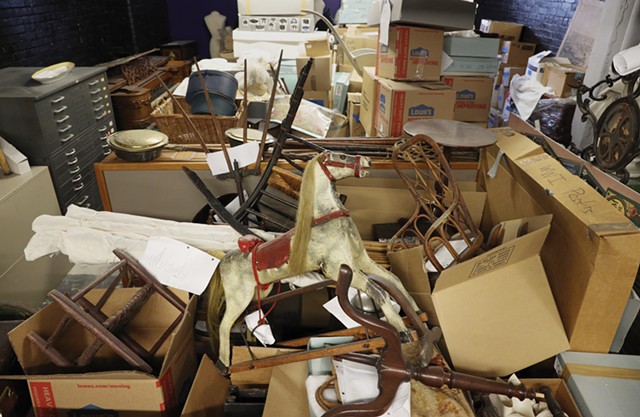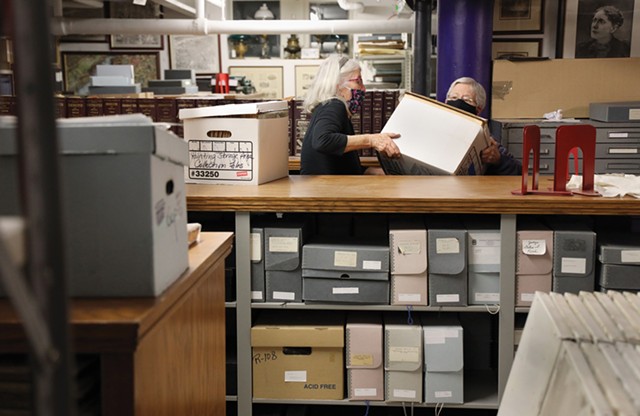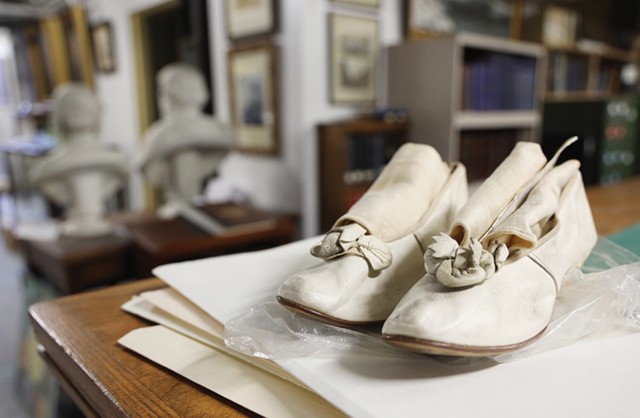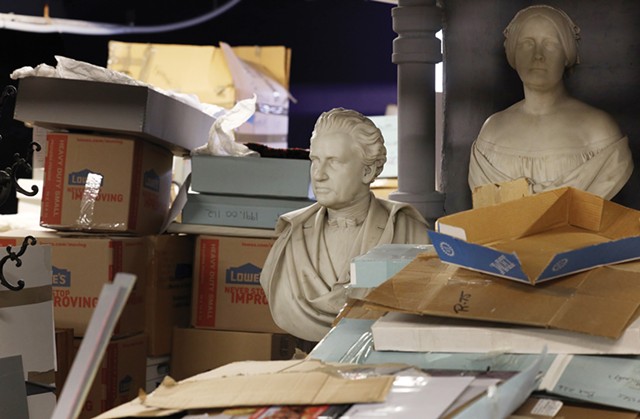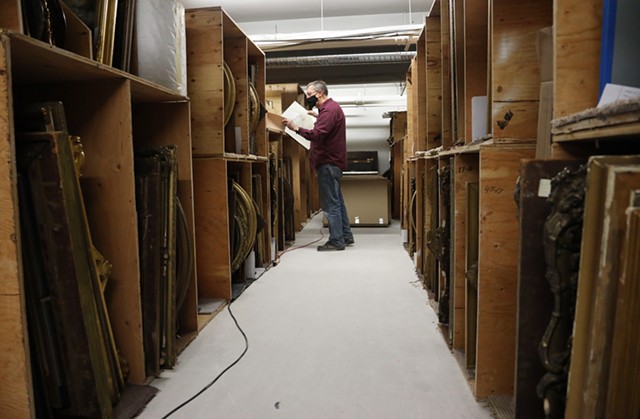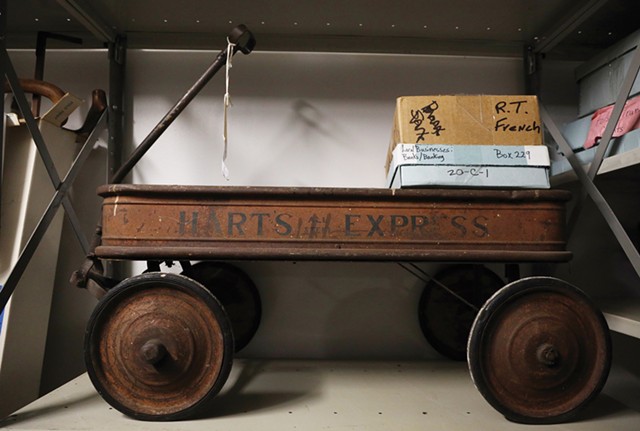[
{
"name": "500x250 Ad",
"insertPoint": "5",
"component": "15667920",
"parentWrapperClass": "",
"requiredCountToDisplay": "1"
}
]
EDITOR'S NOTE 3.15.21: The original version of this story reported that the Rochester Historical Society did not have a website. The society launched its website after the publication of this story, and references to it having none have been removed.
Out of sight and out of mind, Rochester’s oldest cultural institution is floundering, its storied collection shrinking and largely inaccessible to the public.
The Rochester Historical Society, founded 160 years ago, is almost broke. To pay the rent, it periodically sells off items its representatives say are superfluous to its mission of collecting and preserving records and artifacts important to the city’s history.
Meanwhile, the society doesn’t have a full inventory of its holdings, has a lone part-time employee, and has moved four times in the last 12 years. The last was in December, when the society quietly decamped to a cheaper space on University Avenue with less than half the square footage of its previous home.
Historians and museum officials have expressed deep concern, and in some cases outright anger, over the society’s stewardship of a ballyhooed collection that includes belongings of some of the city’s most prominent names, including Susan B. Anthony, Frederick Douglass, and Nathaniel Rochester.
“While it’s common for these institutions to operate on bare-bones budgets, the Rochester Historical Society seems to be a colossal failure, a disaster,” said Michael Leroy Oberg, a distinguished professor of history at SUNY Geneseo.
“It’s sad, because the resources they have are stunning,” Oberg added. “If they still have them.”
The state has been asked to look into the historical society’s collection-management practices, but officials in Albany declined to say if they are doing so. State regulators undertook a similar inquiry a dozen years ago though took no action.
Behind the scenes, movers in the local and state museum world have met several times with society leaders about mapping out a way forward, but none of those discussions have borne fruit; there has been no infusion of cash, no sharing of staff, no facility adequate to showcase the collection.
“For years and years and years, there’ve been discussions about RHS struggling financially, struggling with their storage situation,” said Andrew Marietta, a vice president of the New York Council of Nonprofits, who took part in some of those discussions.
The society’s leaders have resisted interactions that they fear could lead to a splintering of the collection and are loath to lose control over an institution that has endured since the Civil War. While they acknowledge that money is very tight, they deny that the institution’s financial position is so dire as to warrant splitting up the collection.
“Each organization wants a piece of what we have but no one wants to take it on comprehensively,” said Alinda Drury, the society’s vice president. “The society is not in such dire straits that we have to think about divvying it up, and I think there are lot of people in the historical community that don’t want it divvied up.”
A big fear among society leaders, Drury said, is that ceding control to outside organizations could lead to state bureaucrats swooping in and some of Rochester’s most precious artifacts winding up elsewhere.
“We are trying our damnedest to make sure the collections stay more or less intact and in Rochester,” Drury said.
ONCE A MUSEUM
Rochester lacks a true museum of local history. The Rochester Museum and Science Center has large collections of historical material, but its public focus is more on science.
The Genesee Country and Susan B. Anthony museums are good at what they do, and the Landmark Society, George Eastman, Strong, Rush Rhees and others have collections that speak to the past. But none present collections broad enough, nor a mission ambitious enough, to tell the full story of the Rochester region.
The Rochester Historical Society once filled that niche. Today, however, the society, which possesses more than 200,000 artifacts and papers, is quite literally stuck in the past.
The brainchild of the noted Rochester social scientist Lewis Henry Morgan, the society was founded by an act of the state Legislature in 1861. But it remained a paper organization until 1887, when the society was mobilized by Caroline E. Perkins, an active matron with an interest in history and philanthropy who had co-founded Rochester School for the Deaf.
Plans to rejuvenate the moribund group then were said to have been laid at a social affair in Perkins’ mansion on East Avenue — a fitting narrative considering that through much of its history the society was propped up by and run for the edification of wealthy east-side families.
Today, that legacy is an albatross. As those families fell away over time, so too did their largesse toward the society.
“There was a longstanding perception that Rochester Historical was an elite organization that was not public-facing. That was true,” said the society’s president, Carolyn Vacca, a professor who chairs the history department at St. John Fisher College. “That hurt the organization.”
In its early decades, the society played a prominent role in Rochester Society with a capital “S.” It hosted lectures by professional and amateur historians. It collected and preserved the personal papers of accomplished Rochesterians. It opened its collection to historical researchers.
But membership was by invitation only, and there is scant evidence that any of their lectures were open to the public. The collection in those days was lodged in a downtown bank building, then in the private Reynolds Library in a Corn Hill mansion.
That changed in 1912, however, when the society’s papers and growing collection of relics became centerpieces of the new Municipal Museum, a civic celebration of history, science, and industry fashioned from an old prison in Exposition (now Edgerton) Park. Papers were kept secure on site, and items were on display for public view.
Ten years later, the society began publishing bound volumes of historical research papers, a practice that would continue for the next quarter-century. Some papers were less erudite than others, and many trumpeted the lives of the city’s founders and other well-to-do white people to the exclusion of others. But they were nonetheless highly valued by those who study the history of the region.
Those years were the society’s heyday.
But in 1936, the city put the society out on its ear.
The museum at Exposition Park was closing, and those planning a new edifice on East Avenue — what would become the RMSC — wanted no part of the society’s version of local history. The museum’s powerful director, Arthur Parker, dismissed society officials as disorganized amateurs dabbling in history.
Facing homelessness, the organization fell back on benefactors and its old hidebound ways.
It moved temporarily to a small donated building on Lake Avenue until 1941, when a longtime member bequeathed a striking Greek Revival mansion at East Avenue and Sibley Place, known as “Woodside,” that would become the society’s most enduring home.
Woodside would house the collection and open to visitors from time to time. But at its heart, it would be, as the society’s president told the Democrat and Chronicle at the time, “a clubhouse for members, a pleasant place to meet one’s friends, to have a cup of tea by an open fire.”
SELLING THE PAST
To lay people who patronize museums, “deaccessioning,” the term for selling off pieces of a collection, is a dirty word. Attempts to dispose of high-profile works often stir controversy.
In fact, though, deaccessioning is a common practice that is typically reserved for moving items out of a collection that are no longer central to a museum’s mission in order for the museum to raise money to acquire new, more relevant pieces.
The Rochester Historical Society’s aggressive and opaque practice of deaccessioning over the last dozen years or so, however, has raised questions and eyebrows in New York museum circles.
“The sale of collections . . . has been a concern that I’ve heard from other organizations in Rochester and from the Museum Association of New York, for some time,” Marietta said.
Outside experts have asked the state historian to formally request an inquiry by the state Attorney General’s Office, according to Erika Sanger, executive director of the Museum Association, which is based in Troy, outside Albany.
The experts have raised questions both about the society’s deaccessioning practices and its overall collection management, she said.
Sanger said she did not know if State Historian Devin Lander made the request of the attorney general, and neither Lander nor the Attorney General’s Office would comment for this story.
Vacca insists there is no bad blood with Albany. “Devin Lander . . . is a big supporter of Rochester Historical,” she said. “We have not been under any kind of surveillance, or even in moderate disfavor with the state. They are nothing but supportive.”
Outsider experts complain that the society is secretive about its deaccessions and its collections-management policy, and wonder if the society is selling off too much without first offering other local museums a chance to acquire its surplus.
“I am not sure what processes the historical society is going through in order to deaccession the items from their collection that seem to have been sold over the past couple of years,” said Becky Wehle, president and chief executive of Genesee Country Village & Museum.
“It’s hard to say based on what we’re seeing, but there are certainly pieces in the Rochester Historical Society collection that should stay in museums. I would hope that if they got to the point of deaccessioning those, there would be a conversation with other museums,” she said.
Drury said that society officials have notified other museums if significant items are being deaccessioned but only so that those museums can bid on them at auction. The society doesn’t offer the materials directly to other museums, she said.
‘GRANDMA'S ATTIC’
Society officials insisted they are deaccessioning properly, purging only items that are either duplicative or for which the society has been unable to establish a tie to Rochester. For instance, the society has deaccessioned firearms, pieces of furniture, silverware, paintings, and duplicates of clothing.
Daniel Cody, whose job as collections manager from 2010 to 2018 included recommending artifacts for deaccessioning, recalled coming across a collection of dozens of petticoats. “How many do you need?” he asked. “Do you need dozens of them? No.”
In many cases, the society has no idea of the objects’ provenance. For all anyone knows of some items, they could be a souvenir some wealthy patron picked up on an overseas trip and gave to the society.
“There are many, many of these because, as I like to say, we were Grandma's attic, and long ago before there was all the systematic recordkeeping, people just dropped things off,” Vacca said. Because of state rules for deaccessioning, it can take more than a year to dispose of such items.
The society has roughly 1,000 paintings. Some of those that have been sold at auctions were 19th century images of people wealthy enough to commission a portrait, but nobody of an apparent consequence to Rochester.
The most valuable piece the Rochester Historical Society unloaded at auction was an oil painting by Boston artist Charles Sprague Pearce titled “A Peasant Girl” that fetched $63,500 nine years ago.
The society primarily relies on two auction houses for deaccessioning: Cottone Auctions in Geneseo, Livingston County, and Schultz Auctioneers in Clarence, Erie County.
Cottone’s website lists 208 lots from the society that have been offered for sale at auctions dating back to 2012, the Pearce painting among them. Fine art, antique guns, ceremonial swords, none of which had any obvious connection to local history, also drew bids of thousands of dollars.
Still, the occasional appearance on eBay of items listed as being from the Rochester Historical Society has fueled persistent rumors that items have been stolen or were being sold under the table.
Vacca laughed off the speculation, explaining that those items were sold appropriately through auction houses and then offered for resale with the society’s ID tags still attached.
“People are convinced that we are somehow sneaking around and putting stuff out on eBay and selling off the collections, and none of that is true,” Vacca said.
PAYING THE RENT
While the society has never publicly documented its deaccessions, representatives said they provide the state historian with lists of all items that are sold, as required by regulations.
Cody, who kept the records related to deaccessioning during his time at the society, said he never heard about lists of items sold being sent to Albany. He also knew nothing of what society representatives described as a board committee to oversee the disposal of artifacts.
More broadly, though, the society’s former collection manager said he worries the organization’s need for cash might be prompting the board to sell off items it should be keeping. He said he was dismayed to see an ornate wardrobe with local historical connections sold at one recent auction.
“The current board wants to reduce the size of the collection to what they can afford to store,” said Cody, now an adjunct faculty member at Finger Lakes Community College. “And they have only a few hundred members. How are they making money other than by deaccessioning?”
Exactly how much revenue deaccessioning generates for the society is not clear. The society would not provide a copy of its latest tax filing with the IRS, saying it was not complete.
The previous five annual filings, however, suggest the organization auctioned off artifacts worth an estimated $382,500 but netted just under $55,000 from those sales. Society officials attributed the gap to the cost of moving objects to auction, the percentage of the sales taken by auctioneers, and estimated values of items that may have been inflated.
Those figures don’t square with the sale prices on Cottone’s website, which are higher, or with Cody’s recollections.
Drury downplayed the take from deaccessioning, but she and Vacca make no bones about what they do with the money: They use it to help cover the society’s biggest expense — rent.
Cody said deaccessioning revenue was never put to rent when he worked for the society, and both he and other museum experts questioned the appropriateness of the practice.
The state historian’s office declined to comment, saying it had no authority over the historical society’s actions, but referred to state museum regulations, which specify that funds generated by deaccessioning cannot be used for “operating expenses or for any purposes other than the acquisition, preservation, protection or care of collections.”
Vacca and Drury said they consider rent to constitute storage and conservation of the collection, and thus an acceptable use.
“Carolyn has checked with them (state officials) and there has not been an issue with them on that,” Drury said. “We have not been called to task for anything inappropriate.”
LIFE ON THE RUN
The society’s money troubles can be traced to around the turn of the millennium.
Woodside functioned as a meeting place for members as well as a “house museum” filled with period furniture and historic objects. It was open to the public for a small admission fee, but few people came.
If they had, they might have been appalled. The 12,000-square-foot house, stuffed to the rafters with the society’s collection, was a mess and in disrepair.
“It was my job to walk around to make sure the squirrels hadn’t chewed another way into the building,” said Cody, who was an intern at Woodside in 2008.
The society, which then had a staff of two or three, had begun to spend more than it took in — a practice that its financial statements suggest has continued.
Something had to give.
In June 2007, the society’s board dismissed the executive director for overreaching and overspending. A year later, it proposed selling Woodside and moving the bulk of the collection to rented quarters in the Rochester Public Library’s Rundel Memorial Building.
Proponents of the sale said the proceeds would return the society to a sound financial footing, while Rundel would provide secure storage for its artifacts and allow new exhibits that would draw many new patrons.
Opponents on the board predicted the proceeds would be frittered away on rent and the society would wind up having to sell off its collection.
It was the biggest controversy in the society’s history.
Opponents sued to block the sale, and the state Department of Education, whose regents charter museums and oversee their work, began an investigation into the society’s stewardship of its collection.
A state judge ruled in November 2008 that the sale could proceed. Dissidents tried but failed to get the regents to remove the board, and the state probe came to nothing.
As opponents had warned, the move to Rundel proved financially disastrous. Rent ate up money, Vacca recalled, as did legal fees from the Woodsite fight and ambitious programming in the new space.
The society eventually stopped paying rent and in 2014, when its five-year lease expired, it had to leave Rundel. With its savings and income dwindling, the society began to hopscotch across the city.
First it stored its relics in the former Sibley Building, then undergoing renovation. When the owners asked them to leave, the society moved across town in 2016 to an old defense plant on Lincoln Avenue whose owner has carved out space for a variety of groups.
TIGHT QUARTERS
In December, the organization returned to its east-side roots, taking what Vacca called “a wonderful space” in a brick building on University Avenue near Culver Road.
It is, though, a much smaller space than previous quarters; the society had to borrow space elsewhere in the building to fit all of its belongings. The room is below ground level with limited windows — anything but museum-quality storage.
The small size means deaccession will continue, if not accelerate.
“We’ll try to consolidate everything in the space we can afford,” Drury said.
During a recent visit, it was crammed full of shelves of books and stacks of artwork for which there is no wall space. A pile of no-provenance artifacts destined for the auction block sat near the front.
Soon, Vacca said the society hopes to open what she called their “open-stack museum” to the public, with a few visitors at a time negotiating the steps. (There is no elevator.)
Some sort of public access is a must, and outside museum experts have pressed the historical society on this point.
“In their last two locations, public access has been very limited,” said Wehle, of the Genesee Country Village. “Organizations chartered by the state Board of Regents are required to have their collections accessible to the public. The access does not appear to be there right now for people to see the pieces in the collection that are significant.”
There have been a number of sit-downs in recent years with other museums and organizations looking to assist in some capacity. In 2016, talks about a merger or collaboration with Genesee Country Village came to naught.
In March 2019, outside museum officials sat for a meeting with the society that could be seen as an intervention. Lander, the state historian, took part via phone.
“Everyone that was in that room two years ago expressed that we’re deeply concerned that that collection has not been on view for years,” recalled Sanger, of the Museum Association, who was there.
Lack of funds has also hampered one basic undertaking that outside experts pressed for at that 2019 meeting — a full inventory of the society’s collection.
That remains a work in progress, Drury said. So does a project to combine various indices of the society’s documents into a single searchable index that could be put on the website for scholars and laypeople to use.
MONEY IS TIGHT, BUT ‘WE ARE NOT BROKE’
The society’s latest available financial filing shows it took in $70,000 in 2019 and spent $85,000. About $42,000 of its revenue came from contributions from members, who number several hundred. It had about $21,000 in the bank.
Vacca said the society has enough money to keep its head above water.
“We would not have moved to a new location without money to pay the rent. We are not flush but we are not broke,” she said.
The society recently held discussions with Vacca’s employer, St. John Fisher College, that resulted in a scholarship for Fisher students to work with the society’s collection.
Vacca said the college may be able to help it apply for foundation grants that would fund day-to-day operations.
Funding from local government would help, but Vacca and Drury said, somewhat resentfully, that appeals to the city and Monroe County have yielded nothing. Other historical organizations get such funding; in Buffalo, government support allowed the historical society there to operate a full-fledged museum.
Drury acknowledged that the days of the society running the kind of museum where people can meander through exhibits are long gone. Instead, the society is looking to showcase small displays in their own space and in other public locations. Even that, though, will take new funding, Drury said.
Whether other museums and nonprofits in the Rochester region will be able to help — or be allowed to help — is uncertain.
Wehle said collaboration, if there is to be any, will have to start with transparency and open minds.
“The leadership of the historical society should share with the Rochester community what the state of their collection is and what their current financial situation is, so we can all work together to make sure their collections are available to those in the community who want to access them,” she said.
Oberg, the SUNY professor, founded the college’s Geneseo Center for Local and Municipal History to promote and support organizations like the Rochester Historical Society. Rochester’s historical society.
“When you connect people to the history of what happened in their community,” he said, “they learn that they themselves are the forces of history, that their stories matter.”
The society should be making those connections for people in Rochester, he said.
“I think there are ways out of this with creative and energetic leadership,” Oberg said. “There are a lot of people who want to help. There are a lot of historians who would help but haven’t been asked. I don’t know how deep a hole they’re in, but they have treasures.”
Out of sight and out of mind, Rochester’s oldest cultural institution is floundering, its storied collection shrinking and largely inaccessible to the public.
The Rochester Historical Society, founded 160 years ago, is almost broke. To pay the rent, it periodically sells off items its representatives say are superfluous to its mission of collecting and preserving records and artifacts important to the city’s history.
Meanwhile, the society doesn’t have a full inventory of its holdings, has a lone part-time employee, and has moved four times in the last 12 years. The last was in December, when the society quietly decamped to a cheaper space on University Avenue with less than half the square footage of its previous home.
Historians and museum officials have expressed deep concern, and in some cases outright anger, over the society’s stewardship of a ballyhooed collection that includes belongings of some of the city’s most prominent names, including Susan B. Anthony, Frederick Douglass, and Nathaniel Rochester.
“While it’s common for these institutions to operate on bare-bones budgets, the Rochester Historical Society seems to be a colossal failure, a disaster,” said Michael Leroy Oberg, a distinguished professor of history at SUNY Geneseo.
“It’s sad, because the resources they have are stunning,” Oberg added. “If they still have them.”
The state has been asked to look into the historical society’s collection-management practices, but officials in Albany declined to say if they are doing so. State regulators undertook a similar inquiry a dozen years ago though took no action.
Behind the scenes, movers in the local and state museum world have met several times with society leaders about mapping out a way forward, but none of those discussions have borne fruit; there has been no infusion of cash, no sharing of staff, no facility adequate to showcase the collection.
“For years and years and years, there’ve been discussions about RHS struggling financially, struggling with their storage situation,” said Andrew Marietta, a vice president of the New York Council of Nonprofits, who took part in some of those discussions.
The society’s leaders have resisted interactions that they fear could lead to a splintering of the collection and are loath to lose control over an institution that has endured since the Civil War. While they acknowledge that money is very tight, they deny that the institution’s financial position is so dire as to warrant splitting up the collection.
“Each organization wants a piece of what we have but no one wants to take it on comprehensively,” said Alinda Drury, the society’s vice president. “The society is not in such dire straits that we have to think about divvying it up, and I think there are lot of people in the historical community that don’t want it divvied up.”
A big fear among society leaders, Drury said, is that ceding control to outside organizations could lead to state bureaucrats swooping in and some of Rochester’s most precious artifacts winding up elsewhere.
“We are trying our damnedest to make sure the collections stay more or less intact and in Rochester,” Drury said.
ONCE A MUSEUM
Rochester lacks a true museum of local history. The Rochester Museum and Science Center has large collections of historical material, but its public focus is more on science.
The Genesee Country and Susan B. Anthony museums are good at what they do, and the Landmark Society, George Eastman, Strong, Rush Rhees and others have collections that speak to the past. But none present collections broad enough, nor a mission ambitious enough, to tell the full story of the Rochester region.
The Rochester Historical Society once filled that niche. Today, however, the society, which possesses more than 200,000 artifacts and papers, is quite literally stuck in the past.
The brainchild of the noted Rochester social scientist Lewis Henry Morgan, the society was founded by an act of the state Legislature in 1861. But it remained a paper organization until 1887, when the society was mobilized by Caroline E. Perkins, an active matron with an interest in history and philanthropy who had co-founded Rochester School for the Deaf.
Plans to rejuvenate the moribund group then were said to have been laid at a social affair in Perkins’ mansion on East Avenue — a fitting narrative considering that through much of its history the society was propped up by and run for the edification of wealthy east-side families.
Today, that legacy is an albatross. As those families fell away over time, so too did their largesse toward the society.
“There was a longstanding perception that Rochester Historical was an elite organization that was not public-facing. That was true,” said the society’s president, Carolyn Vacca, a professor who chairs the history department at St. John Fisher College. “That hurt the organization.”
In its early decades, the society played a prominent role in Rochester Society with a capital “S.” It hosted lectures by professional and amateur historians. It collected and preserved the personal papers of accomplished Rochesterians. It opened its collection to historical researchers.
But membership was by invitation only, and there is scant evidence that any of their lectures were open to the public. The collection in those days was lodged in a downtown bank building, then in the private Reynolds Library in a Corn Hill mansion.
That changed in 1912, however, when the society’s papers and growing collection of relics became centerpieces of the new Municipal Museum, a civic celebration of history, science, and industry fashioned from an old prison in Exposition (now Edgerton) Park. Papers were kept secure on site, and items were on display for public view.
Ten years later, the society began publishing bound volumes of historical research papers, a practice that would continue for the next quarter-century. Some papers were less erudite than others, and many trumpeted the lives of the city’s founders and other well-to-do white people to the exclusion of others. But they were nonetheless highly valued by those who study the history of the region.
Those years were the society’s heyday.
But in 1936, the city put the society out on its ear.
The museum at Exposition Park was closing, and those planning a new edifice on East Avenue — what would become the RMSC — wanted no part of the society’s version of local history. The museum’s powerful director, Arthur Parker, dismissed society officials as disorganized amateurs dabbling in history.
Facing homelessness, the organization fell back on benefactors and its old hidebound ways.
It moved temporarily to a small donated building on Lake Avenue until 1941, when a longtime member bequeathed a striking Greek Revival mansion at East Avenue and Sibley Place, known as “Woodside,” that would become the society’s most enduring home.
Woodside would house the collection and open to visitors from time to time. But at its heart, it would be, as the society’s president told the Democrat and Chronicle at the time, “a clubhouse for members, a pleasant place to meet one’s friends, to have a cup of tea by an open fire.”
SELLING THE PAST
To lay people who patronize museums, “deaccessioning,” the term for selling off pieces of a collection, is a dirty word. Attempts to dispose of high-profile works often stir controversy.
In fact, though, deaccessioning is a common practice that is typically reserved for moving items out of a collection that are no longer central to a museum’s mission in order for the museum to raise money to acquire new, more relevant pieces.
The Rochester Historical Society’s aggressive and opaque practice of deaccessioning over the last dozen years or so, however, has raised questions and eyebrows in New York museum circles.
“The sale of collections . . . has been a concern that I’ve heard from other organizations in Rochester and from the Museum Association of New York, for some time,” Marietta said.
Outside experts have asked the state historian to formally request an inquiry by the state Attorney General’s Office, according to Erika Sanger, executive director of the Museum Association, which is based in Troy, outside Albany.
The experts have raised questions both about the society’s deaccessioning practices and its overall collection management, she said.
Sanger said she did not know if State Historian Devin Lander made the request of the attorney general, and neither Lander nor the Attorney General’s Office would comment for this story.
Vacca insists there is no bad blood with Albany. “Devin Lander . . . is a big supporter of Rochester Historical,” she said. “We have not been under any kind of surveillance, or even in moderate disfavor with the state. They are nothing but supportive.”
Outsider experts complain that the society is secretive about its deaccessions and its collections-management policy, and wonder if the society is selling off too much without first offering other local museums a chance to acquire its surplus.
“I am not sure what processes the historical society is going through in order to deaccession the items from their collection that seem to have been sold over the past couple of years,” said Becky Wehle, president and chief executive of Genesee Country Village & Museum.
“It’s hard to say based on what we’re seeing, but there are certainly pieces in the Rochester Historical Society collection that should stay in museums. I would hope that if they got to the point of deaccessioning those, there would be a conversation with other museums,” she said.
Drury said that society officials have notified other museums if significant items are being deaccessioned but only so that those museums can bid on them at auction. The society doesn’t offer the materials directly to other museums, she said.
‘GRANDMA'S ATTIC’
Society officials insisted they are deaccessioning properly, purging only items that are either duplicative or for which the society has been unable to establish a tie to Rochester. For instance, the society has deaccessioned firearms, pieces of furniture, silverware, paintings, and duplicates of clothing.
Daniel Cody, whose job as collections manager from 2010 to 2018 included recommending artifacts for deaccessioning, recalled coming across a collection of dozens of petticoats. “How many do you need?” he asked. “Do you need dozens of them? No.”
In many cases, the society has no idea of the objects’ provenance. For all anyone knows of some items, they could be a souvenir some wealthy patron picked up on an overseas trip and gave to the society.
“There are many, many of these because, as I like to say, we were Grandma's attic, and long ago before there was all the systematic recordkeeping, people just dropped things off,” Vacca said. Because of state rules for deaccessioning, it can take more than a year to dispose of such items.
The society has roughly 1,000 paintings. Some of those that have been sold at auctions were 19th century images of people wealthy enough to commission a portrait, but nobody of an apparent consequence to Rochester.
The most valuable piece the Rochester Historical Society unloaded at auction was an oil painting by Boston artist Charles Sprague Pearce titled “A Peasant Girl” that fetched $63,500 nine years ago.
The society primarily relies on two auction houses for deaccessioning: Cottone Auctions in Geneseo, Livingston County, and Schultz Auctioneers in Clarence, Erie County.
Cottone’s website lists 208 lots from the society that have been offered for sale at auctions dating back to 2012, the Pearce painting among them. Fine art, antique guns, ceremonial swords, none of which had any obvious connection to local history, also drew bids of thousands of dollars.
Still, the occasional appearance on eBay of items listed as being from the Rochester Historical Society has fueled persistent rumors that items have been stolen or were being sold under the table.
Vacca laughed off the speculation, explaining that those items were sold appropriately through auction houses and then offered for resale with the society’s ID tags still attached.
“People are convinced that we are somehow sneaking around and putting stuff out on eBay and selling off the collections, and none of that is true,” Vacca said.
PAYING THE RENT
While the society has never publicly documented its deaccessions, representatives said they provide the state historian with lists of all items that are sold, as required by regulations.
Cody, who kept the records related to deaccessioning during his time at the society, said he never heard about lists of items sold being sent to Albany. He also knew nothing of what society representatives described as a board committee to oversee the disposal of artifacts.
More broadly, though, the society’s former collection manager said he worries the organization’s need for cash might be prompting the board to sell off items it should be keeping. He said he was dismayed to see an ornate wardrobe with local historical connections sold at one recent auction.
“The current board wants to reduce the size of the collection to what they can afford to store,” said Cody, now an adjunct faculty member at Finger Lakes Community College. “And they have only a few hundred members. How are they making money other than by deaccessioning?”
Exactly how much revenue deaccessioning generates for the society is not clear. The society would not provide a copy of its latest tax filing with the IRS, saying it was not complete.
The previous five annual filings, however, suggest the organization auctioned off artifacts worth an estimated $382,500 but netted just under $55,000 from those sales. Society officials attributed the gap to the cost of moving objects to auction, the percentage of the sales taken by auctioneers, and estimated values of items that may have been inflated.
Those figures don’t square with the sale prices on Cottone’s website, which are higher, or with Cody’s recollections.
Drury downplayed the take from deaccessioning, but she and Vacca make no bones about what they do with the money: They use it to help cover the society’s biggest expense — rent.
Cody said deaccessioning revenue was never put to rent when he worked for the society, and both he and other museum experts questioned the appropriateness of the practice.
The state historian’s office declined to comment, saying it had no authority over the historical society’s actions, but referred to state museum regulations, which specify that funds generated by deaccessioning cannot be used for “operating expenses or for any purposes other than the acquisition, preservation, protection or care of collections.”
Vacca and Drury said they consider rent to constitute storage and conservation of the collection, and thus an acceptable use.
“Carolyn has checked with them (state officials) and there has not been an issue with them on that,” Drury said. “We have not been called to task for anything inappropriate.”
LIFE ON THE RUN
The society’s money troubles can be traced to around the turn of the millennium.
Woodside functioned as a meeting place for members as well as a “house museum” filled with period furniture and historic objects. It was open to the public for a small admission fee, but few people came.
If they had, they might have been appalled. The 12,000-square-foot house, stuffed to the rafters with the society’s collection, was a mess and in disrepair.
“It was my job to walk around to make sure the squirrels hadn’t chewed another way into the building,” said Cody, who was an intern at Woodside in 2008.
The society, which then had a staff of two or three, had begun to spend more than it took in — a practice that its financial statements suggest has continued.
Something had to give.
In June 2007, the society’s board dismissed the executive director for overreaching and overspending. A year later, it proposed selling Woodside and moving the bulk of the collection to rented quarters in the Rochester Public Library’s Rundel Memorial Building.
Proponents of the sale said the proceeds would return the society to a sound financial footing, while Rundel would provide secure storage for its artifacts and allow new exhibits that would draw many new patrons.
Opponents on the board predicted the proceeds would be frittered away on rent and the society would wind up having to sell off its collection.
It was the biggest controversy in the society’s history.
Opponents sued to block the sale, and the state Department of Education, whose regents charter museums and oversee their work, began an investigation into the society’s stewardship of its collection.
A state judge ruled in November 2008 that the sale could proceed. Dissidents tried but failed to get the regents to remove the board, and the state probe came to nothing.
As opponents had warned, the move to Rundel proved financially disastrous. Rent ate up money, Vacca recalled, as did legal fees from the Woodsite fight and ambitious programming in the new space.
The society eventually stopped paying rent and in 2014, when its five-year lease expired, it had to leave Rundel. With its savings and income dwindling, the society began to hopscotch across the city.
First it stored its relics in the former Sibley Building, then undergoing renovation. When the owners asked them to leave, the society moved across town in 2016 to an old defense plant on Lincoln Avenue whose owner has carved out space for a variety of groups.
TIGHT QUARTERS
In December, the organization returned to its east-side roots, taking what Vacca called “a wonderful space” in a brick building on University Avenue near Culver Road.
It is, though, a much smaller space than previous quarters; the society had to borrow space elsewhere in the building to fit all of its belongings. The room is below ground level with limited windows — anything but museum-quality storage.
The small size means deaccession will continue, if not accelerate.
“We’ll try to consolidate everything in the space we can afford,” Drury said.
During a recent visit, it was crammed full of shelves of books and stacks of artwork for which there is no wall space. A pile of no-provenance artifacts destined for the auction block sat near the front.
Soon, Vacca said the society hopes to open what she called their “open-stack museum” to the public, with a few visitors at a time negotiating the steps. (There is no elevator.)
Some sort of public access is a must, and outside museum experts have pressed the historical society on this point.
“In their last two locations, public access has been very limited,” said Wehle, of the Genesee Country Village. “Organizations chartered by the state Board of Regents are required to have their collections accessible to the public. The access does not appear to be there right now for people to see the pieces in the collection that are significant.”
There have been a number of sit-downs in recent years with other museums and organizations looking to assist in some capacity. In 2016, talks about a merger or collaboration with Genesee Country Village came to naught.
In March 2019, outside museum officials sat for a meeting with the society that could be seen as an intervention. Lander, the state historian, took part via phone.
“Everyone that was in that room two years ago expressed that we’re deeply concerned that that collection has not been on view for years,” recalled Sanger, of the Museum Association, who was there.
Lack of funds has also hampered one basic undertaking that outside experts pressed for at that 2019 meeting — a full inventory of the society’s collection.
That remains a work in progress, Drury said. So does a project to combine various indices of the society’s documents into a single searchable index that could be put on the website for scholars and laypeople to use.
MONEY IS TIGHT, BUT ‘WE ARE NOT BROKE’
The society’s latest available financial filing shows it took in $70,000 in 2019 and spent $85,000. About $42,000 of its revenue came from contributions from members, who number several hundred. It had about $21,000 in the bank.
Vacca said the society has enough money to keep its head above water.
“We would not have moved to a new location without money to pay the rent. We are not flush but we are not broke,” she said.
The society recently held discussions with Vacca’s employer, St. John Fisher College, that resulted in a scholarship for Fisher students to work with the society’s collection.
Vacca said the college may be able to help it apply for foundation grants that would fund day-to-day operations.
Funding from local government would help, but Vacca and Drury said, somewhat resentfully, that appeals to the city and Monroe County have yielded nothing. Other historical organizations get such funding; in Buffalo, government support allowed the historical society there to operate a full-fledged museum.
Drury acknowledged that the days of the society running the kind of museum where people can meander through exhibits are long gone. Instead, the society is looking to showcase small displays in their own space and in other public locations. Even that, though, will take new funding, Drury said.
Whether other museums and nonprofits in the Rochester region will be able to help — or be allowed to help — is uncertain.
Wehle said collaboration, if there is to be any, will have to start with transparency and open minds.
“The leadership of the historical society should share with the Rochester community what the state of their collection is and what their current financial situation is, so we can all work together to make sure their collections are available to those in the community who want to access them,” she said.
Oberg, the SUNY professor, founded the college’s Geneseo Center for Local and Municipal History to promote and support organizations like the Rochester Historical Society. Rochester’s historical society.
“When you connect people to the history of what happened in their community,” he said, “they learn that they themselves are the forces of history, that their stories matter.”
The society should be making those connections for people in Rochester, he said.
“I think there are ways out of this with creative and energetic leadership,” Oberg said. “There are a lot of people who want to help. There are a lot of historians who would help but haven’t been asked. I don’t know how deep a hole they’re in, but they have treasures.”
